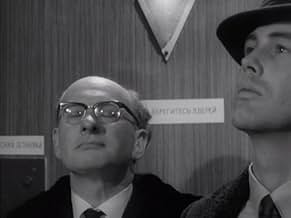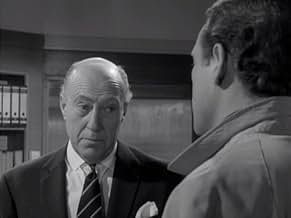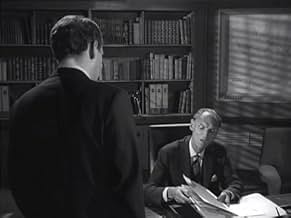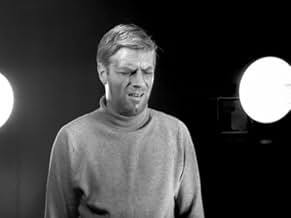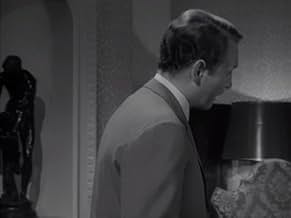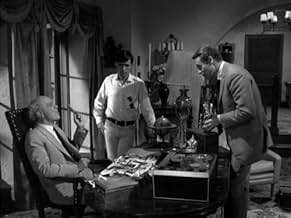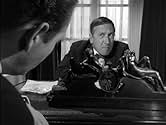ÉVALUATION IMDb
8,2/10
1,7 k
MA NOTE
Ajouter une intrigue dans votre langueJohn Drake is a special operative for M9, specializing in security assignments against any subversive element that threatens world peace.John Drake is a special operative for M9, specializing in security assignments against any subversive element that threatens world peace.John Drake is a special operative for M9, specializing in security assignments against any subversive element that threatens world peace.
Parcourir les épisodes
Avis en vedette
This show never laughs at itself (setting it apart from most of the James Bond and follow-on genre shows). Instead, it projects the inimitable Patrick McGoohan as a consistently efficacious hero: fast-thinking, innovative, ultra-capable, tenaciously-focused on the mission, yet when achieving the mission is not enough, he's able to think outside the box, to re-define his goals and achieve success in a wider context.
For a little boy starving to see a hero on television, "Danger Man" (and the subsequent "Secret Agent Man") was just what I needed. A hundred times over the years, facing my own moments of challenge, I remembered how John Drake had handled things. Nevermind the detail of his job being a "secret agent," the essential of this show is: a man of quintessential skill and reason who uses his mind to take him over, under, around or through all obstacles -- and *that* is what you take away from every episode.
It's food for the soul.
For a little boy starving to see a hero on television, "Danger Man" (and the subsequent "Secret Agent Man") was just what I needed. A hundred times over the years, facing my own moments of challenge, I remembered how John Drake had handled things. Nevermind the detail of his job being a "secret agent," the essential of this show is: a man of quintessential skill and reason who uses his mind to take him over, under, around or through all obstacles -- and *that* is what you take away from every episode.
It's food for the soul.
For forty years, cult T.V. fans have been asking the question: "Who was Number Six?", referring, of course, to Patrick McGoohan's fantasy masterpiece 'The Prisoner'. But in an earlier series, he played a character who was equally mysterious and enigmatic. The show was 'Danger Man' and the character was 'John Drake'.
Throughout the series, we see little of Drake himself. We know he lives in London, at a fashionable mews address, drives a Mini Cooper, is fond of cigars and doesn't seem all that fond of women. Whenever one throws herself at him, such as the Jill Melford character in 'The Galloping Major', he keeps her at arms length. This self-imposed chastity endeared him to us kids, as it meant that the stories could not get bogged down in soppy romantic sub-plots. Like Bond, Drake loves gadgets - the 'From Russia With Love' variety - radios in electric razors, microphones concealed in walking sticks, typewriters containing cameras and so on. Occasionally, Drake is called upon to impersonate an army major, butler, or schoolteacher, which meant his entire personality would go submerged. In this respect, 'Danger Man' was the forerunner to the U.S. series 'Mission:Impossible', which also featured agents about whom the viewer knew next to nothing other than their names.
The series was grounded in reality, unlike the later 'Avengers' and 'U.N.C.L.E.'. Each week, Drake would be assigned to rescue a captured British agent, locate stolen defence plans, or penetrate an enemy spy ring. McGoohan played 'Drake' in a terse, arrogant yet oddly charismatic way, preempting Sean Connery's early performances as 'James Bond'.
'Danger Man' was produced in two batches - one transmitted in Britain in 1959/60, and another from 1964-67. Its the early half-hour episodes which work best for me, being more tightly written and directed. In these, Drake works for N.A.T.O., and appears to be an American, but later on, he would be redefined as an Englishman attached to the British Secret Service outfit M9. Of the hour-long episodes, I cite 'Colony Three' ( the inspiration for 'The Prisoner' ), 'No Marks For Servility', 'Not So Jolly Roger' and 'Whatever Happened To George Foster?' as amongst my personal favourites.
'Danger Man' ended with a rousing two-part colour adventure set in Japan - 'Koroshi' and 'Shinda Shima'. Though not popular with many fans, for my money they rounded off the series nicely, and made one wish McGoohan had done more in similar vein before moving onto 'The Prisoner'.
'Danger Man' does not get repeated often because it was mostly made in black and white. Yet, for anyone who loves '60's action television, it is essential viewing.
Throughout the series, we see little of Drake himself. We know he lives in London, at a fashionable mews address, drives a Mini Cooper, is fond of cigars and doesn't seem all that fond of women. Whenever one throws herself at him, such as the Jill Melford character in 'The Galloping Major', he keeps her at arms length. This self-imposed chastity endeared him to us kids, as it meant that the stories could not get bogged down in soppy romantic sub-plots. Like Bond, Drake loves gadgets - the 'From Russia With Love' variety - radios in electric razors, microphones concealed in walking sticks, typewriters containing cameras and so on. Occasionally, Drake is called upon to impersonate an army major, butler, or schoolteacher, which meant his entire personality would go submerged. In this respect, 'Danger Man' was the forerunner to the U.S. series 'Mission:Impossible', which also featured agents about whom the viewer knew next to nothing other than their names.
The series was grounded in reality, unlike the later 'Avengers' and 'U.N.C.L.E.'. Each week, Drake would be assigned to rescue a captured British agent, locate stolen defence plans, or penetrate an enemy spy ring. McGoohan played 'Drake' in a terse, arrogant yet oddly charismatic way, preempting Sean Connery's early performances as 'James Bond'.
'Danger Man' was produced in two batches - one transmitted in Britain in 1959/60, and another from 1964-67. Its the early half-hour episodes which work best for me, being more tightly written and directed. In these, Drake works for N.A.T.O., and appears to be an American, but later on, he would be redefined as an Englishman attached to the British Secret Service outfit M9. Of the hour-long episodes, I cite 'Colony Three' ( the inspiration for 'The Prisoner' ), 'No Marks For Servility', 'Not So Jolly Roger' and 'Whatever Happened To George Foster?' as amongst my personal favourites.
'Danger Man' ended with a rousing two-part colour adventure set in Japan - 'Koroshi' and 'Shinda Shima'. Though not popular with many fans, for my money they rounded off the series nicely, and made one wish McGoohan had done more in similar vein before moving onto 'The Prisoner'.
'Danger Man' does not get repeated often because it was mostly made in black and white. Yet, for anyone who loves '60's action television, it is essential viewing.
Patrick McGoohan (The Prisoner, Scanners, Braveheart) stars as Secret Agent John Drake in this highly entertaining series full of quick dialogue, twist endings, and inventive storylines that would be right at home on Primetime TV now. McGoohan's subtle yet intense acting and well-choreographed fight scenes, as well as minorities and women in the roles of intelligent, important people are far ahead of their time and worth watching again and again. The characters have a fair amount of depth for a show that's primarily "us-against-them"; the bad guys are sympathetic and the good guys aren't squeaky-clean.
The fact that John Drake occasionally makes mistakes and has to improvise with his wits, luck and humor rather than a series of well-placed gadgets sets this series above the Bond films. It's fast-paced and tightly written...exceedingly clever overall.
McGoohan's acting style reminds me of both Mel Gibson and Ben Browder; he's capable of saying loads of things with no dialogue, is equally adept at humor, action and anger, and can flip emotions quickly. Today's audience may find some of the styles of the other actors a little dated, and the contrast is more pronounced because McGoohan is so much better than most of them.
FIGHTING: The fight scenes are inventive and action-packed. McGoohan's boxing experience shows, but he isn't limited to one fighting style, fights dirty when necessary and isn't above unexpectedly throwing furniture across a room or tossing an adversary down the stairs. There are several back-breaking stunts in the fight scenes which are probably not allowed any more, so if you're a fight buff as I am, they're worth rewinding.
GADGETS: The spy gadgets are for the most part items which could actually exist, and they are brought in as part of a plan rather than the Gothic Trick style gadgets of 007; Drake never has to hope that someone borrows his exploding pen at just the right time. I love Q's inventions, they add humor and flavor to the Bond films, but I find that I don't really miss them since it's clear Drake could beat Bond on an IQ test.
BONUS FOR THE LADIES: If you like James Bond (McGoohan actually turned down the role of James Bond -- twice), but prefer someone who's less of a rake with a bigger sense of humor, this is the guy for you. Not quite funny enough to beat Austin Powers, mind you, but he has better teeth. He's cute, clever and charming and I became a "Drake Drooler" upon my first viewing.
LOVE SCENES: While other characters kiss and have affairs and trade sex for secrets on the show, and Drake clearly enjoys the parties he attends and gambling with the Agency's money, the main character had not one kissing scene throughout the entire series, (which may have something to do with the fact Drake smokes constantly-- his lighter is a camera). I had thought this would make it seem dated, but actually it became an important detail of a well-crafted character, and is part of why I grew to like him better than Bond after only the first disk. I am speaking as a lifetime Bond fan, too, so it wasn't easy for me to admit.
BONUS FOR PRISONER FANS: Fans of McGoohan's cult hit The Prisoner will love to join the scavenger hunt and pick out the characters and clues that have led many to conclude that John Drake and Number 6 are one in the same, or at least that the Everyman in the Prisoner is represented by John Drake. (McGoohan categorically denies this, but it's more fun to play with it.)
Those who have watched The Prisoner may wish to start with set 2, which contains the episode Colony Three, the first appearance of a town full of spies referred to as "The Village". Villagers will also feel quite at home in "The Ubiquitous Mr. Lovegrove", a surreal look into Drake's mind in which he sees Death at every turn. The symbolic use of midnight, mirrors and reflection will satisfy your urge to dissect if you're one of the more fervent Prisoner fans.
Be Seeing You!
The fact that John Drake occasionally makes mistakes and has to improvise with his wits, luck and humor rather than a series of well-placed gadgets sets this series above the Bond films. It's fast-paced and tightly written...exceedingly clever overall.
McGoohan's acting style reminds me of both Mel Gibson and Ben Browder; he's capable of saying loads of things with no dialogue, is equally adept at humor, action and anger, and can flip emotions quickly. Today's audience may find some of the styles of the other actors a little dated, and the contrast is more pronounced because McGoohan is so much better than most of them.
FIGHTING: The fight scenes are inventive and action-packed. McGoohan's boxing experience shows, but he isn't limited to one fighting style, fights dirty when necessary and isn't above unexpectedly throwing furniture across a room or tossing an adversary down the stairs. There are several back-breaking stunts in the fight scenes which are probably not allowed any more, so if you're a fight buff as I am, they're worth rewinding.
GADGETS: The spy gadgets are for the most part items which could actually exist, and they are brought in as part of a plan rather than the Gothic Trick style gadgets of 007; Drake never has to hope that someone borrows his exploding pen at just the right time. I love Q's inventions, they add humor and flavor to the Bond films, but I find that I don't really miss them since it's clear Drake could beat Bond on an IQ test.
BONUS FOR THE LADIES: If you like James Bond (McGoohan actually turned down the role of James Bond -- twice), but prefer someone who's less of a rake with a bigger sense of humor, this is the guy for you. Not quite funny enough to beat Austin Powers, mind you, but he has better teeth. He's cute, clever and charming and I became a "Drake Drooler" upon my first viewing.
LOVE SCENES: While other characters kiss and have affairs and trade sex for secrets on the show, and Drake clearly enjoys the parties he attends and gambling with the Agency's money, the main character had not one kissing scene throughout the entire series, (which may have something to do with the fact Drake smokes constantly-- his lighter is a camera). I had thought this would make it seem dated, but actually it became an important detail of a well-crafted character, and is part of why I grew to like him better than Bond after only the first disk. I am speaking as a lifetime Bond fan, too, so it wasn't easy for me to admit.
BONUS FOR PRISONER FANS: Fans of McGoohan's cult hit The Prisoner will love to join the scavenger hunt and pick out the characters and clues that have led many to conclude that John Drake and Number 6 are one in the same, or at least that the Everyman in the Prisoner is represented by John Drake. (McGoohan categorically denies this, but it's more fun to play with it.)
Those who have watched The Prisoner may wish to start with set 2, which contains the episode Colony Three, the first appearance of a town full of spies referred to as "The Village". Villagers will also feel quite at home in "The Ubiquitous Mr. Lovegrove", a surreal look into Drake's mind in which he sees Death at every turn. The symbolic use of midnight, mirrors and reflection will satisfy your urge to dissect if you're one of the more fervent Prisoner fans.
Be Seeing You!
Believe it or not, I did not see any of this programme until 1992-93. It was shown one per night on CBC-Windsor at difficult to establish late hours. In spite of the inconvenience, I made it my business to see as many as possible; my first was when Drake had a car crash, blacking out . . . and you will just have to see it.
It was well cast with well-crafted supporting characters. I had no idea it was the progeny of an earlier show about a NATO operative, a few episodes of which I saw in 1961 (and none since). One notes comment that SECRET AGENT was inspired by the 007 films, which is beyond dispute, but I respectfully disagree that it was as "gadgety" as the Bond films, and furthermore it was devoid of the latent camp. Exception: "Would You Like Some Wine" (if memory serves). Perhaps it was the b.&w. presentation that made it more -- pardon the cliche -- gritty.
Most of the episodes were good. It seems some of the later ones (did the series run into 1967?) were the weakest: Far-fetched and in a few cases ridiculous without being tongue-in-cheek. I cannot say whether SECRET AGENT came to an end because it ran out of petrol or because the more ambitious THE PRISONER was on the drawing boards. All said, I agree that one should make every attempt to see the series, and no, being period piece does not distract for those able to make a mature adjustment to such.
It was well cast with well-crafted supporting characters. I had no idea it was the progeny of an earlier show about a NATO operative, a few episodes of which I saw in 1961 (and none since). One notes comment that SECRET AGENT was inspired by the 007 films, which is beyond dispute, but I respectfully disagree that it was as "gadgety" as the Bond films, and furthermore it was devoid of the latent camp. Exception: "Would You Like Some Wine" (if memory serves). Perhaps it was the b.&w. presentation that made it more -- pardon the cliche -- gritty.
Most of the episodes were good. It seems some of the later ones (did the series run into 1967?) were the weakest: Far-fetched and in a few cases ridiculous without being tongue-in-cheek. I cannot say whether SECRET AGENT came to an end because it ran out of petrol or because the more ambitious THE PRISONER was on the drawing boards. All said, I agree that one should make every attempt to see the series, and no, being period piece does not distract for those able to make a mature adjustment to such.
'Secret Agent' was the series that preceded Patrick McGoohan's 'The Prisoner'. Having seen 'Secret Agent' for the first time makes you understand 'The Prisoner' much more. The agent that resigned in 'The Prisoner' is probably John Drake of 'Secret Agent'. It was a brilliant espionage TV series with many ideas that were later seen in the 'James Bond' movies and 'Mission Impossible'. It was brilliantly written and played and although most of the episodes are in black and white, it doesn't make much difference as long as it is so fascinating and reliable. It really stands the test of time. Every episode is different than the other but they all involve spy games. The quality of the series exceeds anything we see today. So Patrick, why did you resign?
Le saviez-vous
- AnecdotesAfter two seasons of black-and-white episodes, it was decided to switch to colour production. But after only two episodes were completed, McGoohan quit the series to devote his energies to The Prisoner (1967). These two episodes of the third season, Koroshi (1967) and Shinda Shima (1967) were edited together to form the movie Koroshi (1968).
- Générique farfeluThe first episode broadcast in the United States ("Battle of the Cameras") actually features two opening credit sequences. The first is a brief, 10-second introduction featuring a few bars of "Secret Agent Man" and a credit for Patrick McGoohan (running roughly the same length as the original UK credits). This is followed by the teaser, and then the regular credits. In all future US broadcasts, the pre-teaser credit sequence was dropped.
- Autres versionsTwo color episodes were produced as part of a season that was interrupted when McGoohan quit the series to make "The Prisoner." These two episodes were edited together to form the movie Koroshi (1968). The original unedited episodes were released on video in the UK in the 1980s.
- ConnexionsEdited into Koroshi (1968)
Meilleurs choix
Connectez-vous pour évaluer et surveiller les recommandations personnalisées
- How many seasons does Secret Agent have?Propulsé par Alexa
Détails
- Date de sortie
- Pays d’origine
- Site officiel
- Langue
- Aussi connu sous le nom de
- Secret Agent
- Lieux de tournage
- société de production
- Consultez plus de crédits d'entreprise sur IMDbPro
- Durée49 minutes
- Rapport de forme
- 1.33 : 1
Contribuer à cette page
Suggérer une modification ou ajouter du contenu manquant


